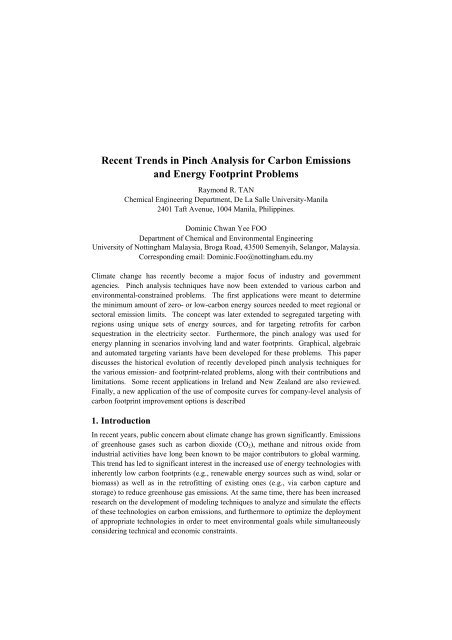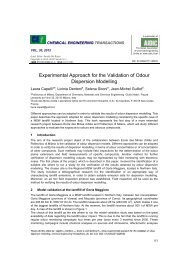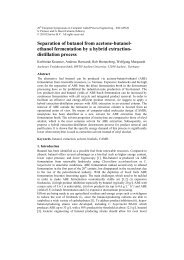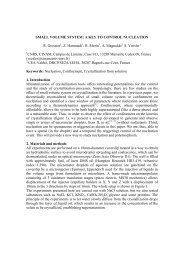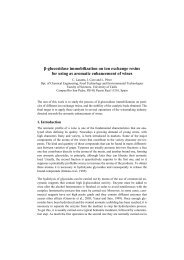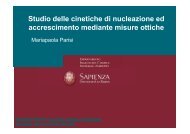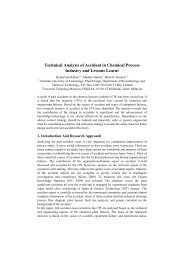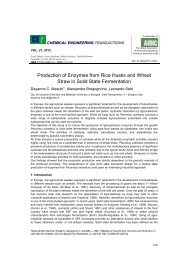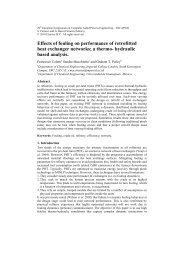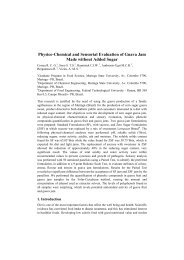Recent Trends in Pinch Analysis for Carbon Emissions and ... - Aidic
Recent Trends in Pinch Analysis for Carbon Emissions and ... - Aidic
Recent Trends in Pinch Analysis for Carbon Emissions and ... - Aidic
You also want an ePaper? Increase the reach of your titles
YUMPU automatically turns print PDFs into web optimized ePapers that Google loves.
<strong>Recent</strong> <strong>Trends</strong> <strong>in</strong> P<strong>in</strong>ch <strong>Analysis</strong> <strong>for</strong> <strong>Carbon</strong> <strong>Emissions</strong><br />
<strong>and</strong> Energy Footpr<strong>in</strong>t Problems<br />
Raymond R. TAN<br />
Chemical Eng<strong>in</strong>eer<strong>in</strong>g Department, De La Salle University-Manila<br />
2401 Taft Avenue, 1004 Manila, Philipp<strong>in</strong>es.<br />
Dom<strong>in</strong>ic Chwan Yee FOO<br />
Department of Chemical <strong>and</strong> Environmental Eng<strong>in</strong>eer<strong>in</strong>g<br />
University of Nott<strong>in</strong>gham Malaysia, Broga Road, 43500 Semenyih, Selangor, Malaysia.<br />
Correspond<strong>in</strong>g email: Dom<strong>in</strong>ic.Foo@nott<strong>in</strong>gham.edu.my<br />
Climate change has recently become a major focus of <strong>in</strong>dustry <strong>and</strong> government<br />
agencies. P<strong>in</strong>ch analysis techniques have now been extended to various carbon <strong>and</strong><br />
environmental-constra<strong>in</strong>ed problems. The first applications were meant to determ<strong>in</strong>e<br />
the m<strong>in</strong>imum amount of zero- or low-carbon energy sources needed to meet regional or<br />
sectoral emission limits. The concept was later extended to segregated target<strong>in</strong>g with<br />
regions us<strong>in</strong>g unique sets of energy sources, <strong>and</strong> <strong>for</strong> target<strong>in</strong>g retrofits <strong>for</strong> carbon<br />
sequestration <strong>in</strong> the electricity sector. Furthermore, the p<strong>in</strong>ch analogy was used <strong>for</strong><br />
energy plann<strong>in</strong>g <strong>in</strong> scenarios <strong>in</strong>volv<strong>in</strong>g l<strong>and</strong> <strong>and</strong> water footpr<strong>in</strong>ts. Graphical, algebraic<br />
<strong>and</strong> automated target<strong>in</strong>g variants have been developed <strong>for</strong> these problems. This paper<br />
discusses the historical evolution of recently developed p<strong>in</strong>ch analysis techniques <strong>for</strong><br />
the various emission- <strong>and</strong> footpr<strong>in</strong>t-related problems, along with their contributions <strong>and</strong><br />
limitations. Some recent applications <strong>in</strong> Irel<strong>and</strong> <strong>and</strong> New Zeal<strong>and</strong> are also reviewed.<br />
F<strong>in</strong>ally, a new application of the use of composite curves <strong>for</strong> company-level analysis of<br />
carbon footpr<strong>in</strong>t improvement options is described<br />
1. Introduction<br />
In recent years, public concern about climate change has grown significantly. <strong>Emissions</strong><br />
of greenhouse gases such as carbon dioxide (CO2), methane <strong>and</strong> nitrous oxide from<br />
<strong>in</strong>dustrial activities have long been known to be major contributors to global warm<strong>in</strong>g.<br />
This trend has led to significant <strong>in</strong>terest <strong>in</strong> the <strong>in</strong>creased use of energy technologies with<br />
<strong>in</strong>herently low carbon footpr<strong>in</strong>ts (e.g., renewable energy sources such as w<strong>in</strong>d, solar or<br />
biomass) as well as <strong>in</strong> the retrofitt<strong>in</strong>g of exist<strong>in</strong>g ones (e.g., via carbon capture <strong>and</strong><br />
storage) to reduce greenhouse gas emissions. At the same time, there has been <strong>in</strong>creased<br />
research on the development of model<strong>in</strong>g techniques to analyze <strong>and</strong> simulate the effects<br />
of these technologies on carbon emissions, <strong>and</strong> furthermore to optimize the deployment<br />
of appropriate technologies <strong>in</strong> order to meet environmental goals while simultaneously<br />
consider<strong>in</strong>g technical <strong>and</strong> economic constra<strong>in</strong>ts.
A number of papers have recently been published on the use of p<strong>in</strong>ch analysis methods<br />
<strong>for</strong> such applications. P<strong>in</strong>ch analysis techniques date back to early work <strong>in</strong> the 1970’s<br />
on the systematic design of heat recovery systems (L<strong>in</strong>nhoff et al., 1982; Smith, 1995).<br />
Even though these early applications focused on the economic implications of energy<br />
sav<strong>in</strong>gs, the enhanced energy efficiency also contributes significantly to the emission<br />
reduction of process plants. Further applications were demonstrated also to the analysis<br />
of emissions <strong>for</strong> total sites (Dhole <strong>and</strong> L<strong>in</strong>nhoff, 1992; L<strong>in</strong>nhoff <strong>and</strong> Dhole, 1993;<br />
Klemeš et al., 1997). In the late 1980’s, mass <strong>in</strong>tegration techniques were developed<br />
based on the analogies between heat <strong>and</strong> mass transfer (El-Halwagi <strong>and</strong><br />
Manousiothakis, 1989; El-Halwagi, 1997, 2006). The work concept was later extended<br />
to water network synthesis (Wang <strong>and</strong> Smith, 1995; El-halwagi et al., 2003; Manan et<br />
al., 2004; Prakash <strong>and</strong> Shenoy, 2005; Foo et al., 2006a; Ng et al., 2007) <strong>and</strong> property<br />
<strong>in</strong>tegration (Kazantzi <strong>and</strong> El-Halwagi, 2005; Foo et al., 2006b). These various p<strong>in</strong>ch<br />
analysis techniques <strong>in</strong>clude graphical <strong>and</strong> numerical approaches.<br />
More recently, p<strong>in</strong>ch analysis concepts were extended to applications <strong>in</strong>volv<strong>in</strong>g<br />
management of CO2 emissions from <strong>in</strong>dustrial systems. The development of these<br />
techniques is discussed <strong>in</strong> the next section.<br />
2. Brief Review of <strong>Carbon</strong> Emission P<strong>in</strong>ch <strong>Analysis</strong> (CEPA)<br />
Tan <strong>and</strong> Foo (2007) developed the first approach on the use of p<strong>in</strong>ch analysis technique<br />
<strong>for</strong> carbon constra<strong>in</strong>ed energy sector plann<strong>in</strong>g, <strong>in</strong> short <strong>Carbon</strong> Emission P<strong>in</strong>ch <strong>Analysis</strong><br />
(CEPA). The method assumes that with<strong>in</strong> the system, there exists a set of energy<br />
sources, each with a specific carbon <strong>in</strong>tensity characteristic of the fuel or the<br />
technology. At the same time, the system also conta<strong>in</strong>s a set of energy dem<strong>and</strong>s, <strong>and</strong><br />
that each dem<strong>and</strong> has a specified carbon footpr<strong>in</strong>t limit. Alternatively, a total carbon<br />
footpr<strong>in</strong>t limit may be specified <strong>for</strong> all of the dem<strong>and</strong>s comb<strong>in</strong>ed. Under the assumption<br />
that the various energy sources are fully <strong>in</strong>terchangeable, the orig<strong>in</strong>al problem was to<br />
m<strong>in</strong>imize the amount of zero-carbon energy sources (i.e., renewable energy or noncombustion<br />
based sources such as nuclear or geothermal power) needed <strong>in</strong> order to<br />
satisfy the specified carbon footpr<strong>in</strong>t limits. The orig<strong>in</strong>al technique made use of energy<br />
plann<strong>in</strong>g composite curves similar to those used <strong>for</strong> water recovery (El-Halwagi et al.,<br />
2003; Prakash <strong>and</strong> Shenoy, 2005) us<strong>in</strong>g energy as the horizontal axis <strong>and</strong> CO2 emissions<br />
as the vertical axis (Figure 1). The basic technique has s<strong>in</strong>ce been applied <strong>for</strong> energy<br />
plann<strong>in</strong>g purposes by researchers <strong>in</strong> Irel<strong>and</strong> (Crilly <strong>and</strong> Zhelev, 2008a) <strong>and</strong> New<br />
Zeal<strong>and</strong> (Atk<strong>in</strong>s et al., 2008). The latter work presents an <strong>in</strong>terest<strong>in</strong>g extension that<br />
takes <strong>in</strong>to account the growth <strong>in</strong> energy dem<strong>and</strong> with<strong>in</strong> a sector over time.<br />
The next development <strong>in</strong> CEPA was the use of an equivalent numerical approach to<br />
solve similar problems (Foo et al., 2008). The extension is based on the established<br />
equivalence between graphical techniques (El-Halwagi et al., 2003; Prakash <strong>and</strong><br />
Shenoy, 2005)<strong>and</strong> numerical ones (Manan et al., 2004; Foo et al., 2006a). Furthermore,<br />
it was soon recognized that the assumption of zero-carbon technologies had to be<br />
relaxed, as even non-combustion based technologies had small carbon footpr<strong>in</strong>ts when<br />
life cycle considerations are taken <strong>in</strong>to account. Hence, a subsequent paper published<br />
recently accounts <strong>for</strong> such low-carbon technologies by allow<strong>in</strong>g the composite curves to<br />
be shifted diagonally along a shallow locus, rather than horizontally as <strong>in</strong> the orig<strong>in</strong>al
method (Lee et al., 2009). At the same time, two other new elements were proposed <strong>in</strong><br />
the work of Lee et al. (2009). The authors re<strong>for</strong>mulate the CEPA target<strong>in</strong>g technique as<br />
a l<strong>in</strong>ear programm<strong>in</strong>g model that m<strong>in</strong>imize the amount of zero- or low-carbon sources<br />
<strong>in</strong> an automated way. Furthermore, the concept of segregated target<strong>in</strong>g was <strong>in</strong>troduced,<br />
<strong>in</strong> which not all energy sources can be used <strong>in</strong>terchangeably by the dem<strong>and</strong>s (Lee et al.,<br />
2009). <strong>Recent</strong>ly, a new decomposition algorithm was also developed to solve the<br />
segregated target<strong>in</strong>g problem (B<strong>and</strong>yopadhyay et al., 2009). These methodologies have<br />
all been developed based on the concept of carbon <strong>in</strong>tensity as the “quality” <strong>in</strong>dex <strong>for</strong><br />
energy streams. Alternative applications have also been proposed us<strong>in</strong>g different quality<br />
<strong>in</strong>dices <strong>for</strong> biomass-based energy, <strong>in</strong>clud<strong>in</strong>g l<strong>and</strong> area (Foo et al., 2008) <strong>and</strong> water<br />
footpr<strong>in</strong>t (Tan et al., 2009a), as well as emergy (Crilly <strong>and</strong> Zhelev, 2008b;<br />
B<strong>and</strong>yopadhyay et al., 2009).<br />
The most recent application of p<strong>in</strong>ch analysis <strong>in</strong> this area is <strong>for</strong> the plann<strong>in</strong>g of m<strong>in</strong>imal<br />
retrofit of power plants <strong>for</strong> carbon capture <strong>and</strong> storage (Tan et al., 2009b). In this work,<br />
p<strong>in</strong>ch analysis is used to determ<strong>in</strong>e the m<strong>in</strong>imum extent of retrofitt<strong>in</strong>g needed across a<br />
region’s power plants <strong>in</strong> order to meet an overall carbon footpr<strong>in</strong>t target. Note that<br />
retrofitt<strong>in</strong>g <strong>in</strong> general is undesirable as it entails capital costs <strong>for</strong> retrofitt<strong>in</strong>g as well as<br />
energy losses due to the power requirements <strong>for</strong> carbon capture <strong>and</strong> storage processes.<br />
The approach assumes that compensation <strong>for</strong> such power losses is accomplished by<br />
<strong>in</strong>stall<strong>in</strong>g additional zero-emission plants us<strong>in</strong>g renewable energy.<br />
3. New Application of CEPA <strong>for</strong> <strong>Carbon</strong> Footpr<strong>in</strong>ts Reduction<br />
This section briefly outl<strong>in</strong>es a novel application of carbon p<strong>in</strong>ch analysis <strong>for</strong> companies<br />
to determ<strong>in</strong>e strategies to reduce their carbon footpr<strong>in</strong>ts. Note that the carbon footpr<strong>in</strong>t<br />
is a life cycle based concept that measures the total emissions generated, tak<strong>in</strong>g <strong>in</strong>to<br />
account an <strong>in</strong>ternal component (generated by the company itself) <strong>and</strong> an external one<br />
(generated upstream of the company by its supply cha<strong>in</strong>). The concept is closely l<strong>in</strong>ked<br />
to life cycle assessment (LCA) <strong>and</strong> may be viewed as a simplified <strong>for</strong>m of the latter<br />
(Weidema et al., 2008). A graphical technique has been proposed <strong>for</strong> visualiz<strong>in</strong>g carbon<br />
footpr<strong>in</strong>ts of companies (Tahara et al., 2005) that resembles the appearance of the<br />
energy plann<strong>in</strong>g composite curves (Tan <strong>and</strong> Foo, 2007), but which does not explicitly<br />
make use of p<strong>in</strong>ch pr<strong>in</strong>ciples. Here, a revised methodology is proposed to comb<strong>in</strong>e these<br />
prior concepts.<br />
In general, the total carbon footpr<strong>in</strong>t of a company consists of <strong>in</strong>ternal <strong>and</strong> external<br />
components. At the same time, the value of goods produced <strong>in</strong> an <strong>in</strong>dustrial process<br />
consists of the value of the <strong>in</strong>puts, plus the value added <strong>in</strong>ternally by the firm itself. The<br />
ratio of the carbon footpr<strong>in</strong>t to the economic value is termed as the carbon <strong>in</strong>tensity.<br />
Note that, <strong>in</strong> general, the carbon <strong>in</strong>tensities of the <strong>in</strong>ternal <strong>and</strong> external components need<br />
not be the same. These components can thus be plotted as the source composite curve <strong>in</strong><br />
Figure 1, us<strong>in</strong>g the same approach as <strong>in</strong> the orig<strong>in</strong>al CEPA technique (Tan <strong>and</strong> Foo,<br />
2007), with economic value along the horizontal axis <strong>and</strong> CO2 emissions on the vertical<br />
axis. We apply the convention of plott<strong>in</strong>g the external component first, as shown <strong>in</strong><br />
Figure 1. Note that if a diagonal l<strong>in</strong>e is drawn from the orig<strong>in</strong> to the term<strong>in</strong>al po<strong>in</strong>t of<br />
the source composite curve, the slope of the l<strong>in</strong>e is equivalent to the overall carbon<br />
<strong>in</strong>tensity of the company, comb<strong>in</strong><strong>in</strong>g both <strong>in</strong>ternal <strong>and</strong> external component.
CO2 emission<br />
Internal<br />
footpr<strong>in</strong>t<br />
External<br />
footpr<strong>in</strong>t<br />
<strong>Carbon</strong> <strong>in</strong>tensity benchmark<br />
Dem<strong>and</strong><br />
composite<br />
Source<br />
composite<br />
Adjusted<br />
source<br />
composite<br />
Cost Value added<br />
Figure 1. <strong>Carbon</strong> Footpr<strong>in</strong>t Composite Curves (Scenario 1)<br />
Economic<br />
Total CO2<br />
emission<br />
Next, it is assumed that a benchmark carbon <strong>in</strong>tensity level is set, which is lower that<br />
the company total carbon <strong>in</strong>tensity. This benchmark may be based on <strong>in</strong>dustry<br />
st<strong>and</strong>ards, competitive benchmark<strong>in</strong>g, or <strong>in</strong>ternal company choices, <strong>and</strong> may act as a<br />
dem<strong>and</strong> composite curve (see Figure 1). In any case, the problem is <strong>for</strong> the company to<br />
determ<strong>in</strong>e general strategies to reduce its carbon <strong>in</strong>tensity from the current level to the<br />
desired value.<br />
Two scenarios may be considered. In Scenario 1, if the external carbon <strong>in</strong>tensity<br />
(represented by its slope of the segment) is lower than the <strong>in</strong>ternal one, such as that<br />
shown <strong>in</strong> Figure 1, the appropriate strategy is to reduce the <strong>in</strong>ternal carbon footpr<strong>in</strong>t of<br />
the company. Graphically, the result is a reduction <strong>in</strong> the slope of the <strong>in</strong>ternal footpr<strong>in</strong>t<br />
segment of the source composite curve, until it touches the dem<strong>and</strong> composite curve.<br />
Thus, it is possible to see how much the <strong>in</strong>ternal carbon <strong>in</strong>tensity needs to be reduced to<br />
meet the benchmark level.<br />
In Scenario 2, the external carbon footpr<strong>in</strong>t has a much higher <strong>in</strong>tensity than the <strong>in</strong>ternal<br />
one (Figure 2). Note that the source composite curve now lies completely above the<br />
dem<strong>and</strong> composite curve that denotes the benchmark value <strong>for</strong> carbon <strong>in</strong>tensity. In this<br />
case, the appropriate strategy <strong>for</strong> the company is to reduce the length of the external<br />
footpr<strong>in</strong>t segment. This is equivalent to shift<strong>in</strong>g the <strong>in</strong>ternal footpr<strong>in</strong>t component<br />
diagonally, along the external footpr<strong>in</strong>t segment of the source composite curve. The<br />
shift<strong>in</strong>g is done until the tip of the composite curve touches the carbon <strong>in</strong>tensity<br />
benchmark, as shown <strong>in</strong> Figure 2. As a result, the external footpr<strong>in</strong>t of the product is<br />
reduced, corresponds to the <strong>in</strong>crease of the <strong>in</strong>ternal footpr<strong>in</strong>t (see Figure 2). In practical<br />
terms, this implies that companies with low <strong>in</strong>ternal carbon footpr<strong>in</strong>ts can best reduce<br />
their carbon <strong>in</strong>tensity simply by reduc<strong>in</strong>g the use of external <strong>in</strong>puts per unit of product,<br />
as these <strong>in</strong>puts conta<strong>in</strong> embedded carbon footpr<strong>in</strong>ts that become part of the overall<br />
company footpr<strong>in</strong>t.
CO2 emission<br />
Internal<br />
footpr<strong>in</strong>t<br />
External<br />
footpr<strong>in</strong>t<br />
Figure 2. <strong>Carbon</strong> Footpr<strong>in</strong>t Composite Curves (Scenario 2)<br />
4. Conclusion<br />
P<strong>in</strong>ch analysis techniques have recently been extended <strong>for</strong> various applications<br />
<strong>in</strong>volv<strong>in</strong>g management of carbon emissions <strong>in</strong> response to climate change issued.<br />
Several methodological (graphical <strong>and</strong> numerical) approaches have been developed to<br />
such problems as energy allocation, segregated target<strong>in</strong>g, <strong>and</strong> retrofit plann<strong>in</strong>g. At the<br />
same time, similar applications <strong>for</strong> consider<strong>in</strong>g emergy, l<strong>and</strong> <strong>and</strong> water footpr<strong>in</strong>t issues<br />
<strong>in</strong> energy <strong>and</strong> biofuel systems have been developed. These methodologies <strong>and</strong> recent<br />
applications have been reviewed here. F<strong>in</strong>ally, a novel application has also been<br />
developed on the use of graphical p<strong>in</strong>ch analysis <strong>for</strong> determ<strong>in</strong><strong>in</strong>g strategies to meet<br />
corporate carbon <strong>in</strong>tensity benchmarks.<br />
References<br />
<strong>Carbon</strong> <strong>in</strong>tensity benchmark<br />
Source<br />
composite<br />
Dem<strong>and</strong><br />
composite<br />
Cost Value added<br />
Adjusted source<br />
composite<br />
Increased<br />
<strong>in</strong>ternal<br />
footpr<strong>in</strong>t<br />
Reduced<br />
external<br />
footpr<strong>in</strong>t<br />
Economic<br />
Atk<strong>in</strong>s M.J., Morrison A.S., Walmsley M.R.W., 2008, <strong>Carbon</strong> emissions p<strong>in</strong>ch analysis<br />
(CEPA) <strong>for</strong> emissions reduction <strong>in</strong> the New Zeal<strong>and</strong> electricity sector. Paper<br />
presented <strong>in</strong> Society of Chemical Eng<strong>in</strong>eers New Zeal<strong>and</strong> Annual Conference<br />
(SCENZ08), New Zeal<strong>and</strong>.<br />
B<strong>and</strong>yopadhyay S., Foo D.C.Y. <strong>and</strong> Tan R.R., 2009, Segregated Target<strong>in</strong>g <strong>for</strong> Multiple<br />
Resources Us<strong>in</strong>g Decomposition Pr<strong>in</strong>ciple, AIChE J. (submitted).<br />
Crilly D, Zhelev T., 2008a, <strong>Emissions</strong> target<strong>in</strong>g <strong>and</strong> plann<strong>in</strong>g - an application of CO2<br />
emissions p<strong>in</strong>ch analysis (CEPA) to the Irish electricity generation sector. Energy<br />
33, 1498-1507.<br />
Crilly D., Zhelev, T., 2008b, An emergy-based target<strong>in</strong>g technique <strong>for</strong> treatment <strong>and</strong><br />
utilisation of greenhouse gas emissions. paper presented <strong>in</strong> the 18 th International<br />
Congress of Chemical <strong>and</strong> Process Eng<strong>in</strong>eer<strong>in</strong>g (CHISA), Czech Republic.<br />
Dhole V.R. <strong>and</strong> L<strong>in</strong>nhoff B., 1992, Total site targets <strong>for</strong> fuel, co-generation, emissions,<br />
<strong>and</strong> cool<strong>in</strong>g. Comp. Chem. Eng. 17, S101-S109.<br />
El-Halwagi M.M. <strong>and</strong> Manousiothakis V., 1989, Simultaneous synthesis of massexchange<br />
<strong>and</strong> regeneration networks. AIChE J. 36: 1209-1219.
El-Halwagi M.M. 1997, Pollution Prevention through Process Integration: systematic<br />
design tools. Academic Press, San Diego.<br />
El-Halwagi M.M. 2006, Process Integration. Elsevier, Amsterdam.<br />
El-Halwagi M.M., Gabriel F. <strong>and</strong> Harell D., 2003, Rigorous graphical target<strong>in</strong>g <strong>for</strong><br />
resource conservation via material recycle/reuse networks. Ind. Eng. Chem. Res. 42,<br />
4319-4328.<br />
Foo D.C.Y., Manan Z.A. <strong>and</strong> Tan Y.L. 2006, Use cascade analysis to optimize water<br />
networks, Chem. Eng. Prog. 102, 45-52.<br />
Foo D.C.Y., Kazantzi V., El-Halwagi M.M. <strong>and</strong> Manan Z.A., 2006b, Surplus diagram<br />
<strong>and</strong> cascade analysis technique <strong>for</strong> target<strong>in</strong>g property-based material reuse network.<br />
Chem. Eng. Sci. 61, 2626-2642.<br />
Foo D.C.Y., Tan R.R. <strong>and</strong> Ng D.K.S., 2008, <strong>Carbon</strong> <strong>and</strong> footpr<strong>in</strong>t-constra<strong>in</strong>ed energy<br />
sector plann<strong>in</strong>g us<strong>in</strong>g cascade analysis technique. Energy 33, 1480-88.<br />
Kazantzi V., <strong>and</strong> El-Halwagi M.M., 2005, Target<strong>in</strong>g material reuse via property<br />
<strong>in</strong>tegration. Chem. Eng. Prog. 101, 28-37.<br />
Klemeš J., Dhole V.R., Raissi K., Perry S.J., Puigjaner L., 1997, Target<strong>in</strong>g <strong>and</strong> design<br />
methodology <strong>for</strong> reduction of fuel, power <strong>and</strong> CO2 on total sites. Appl. Therm. Eng.<br />
17, 993-1003.<br />
Lee S.C., Ng D.K.S., Foo D.C.Y. <strong>and</strong> Tan R.R., 2009, Extended p<strong>in</strong>ch target<strong>in</strong>g<br />
techniques <strong>for</strong> carbon-constra<strong>in</strong>ed energy sector plann<strong>in</strong>g. Appl. Energy 86, 60-67.<br />
L<strong>in</strong>nhoff B., Townsend D.W., Bol<strong>and</strong> D., Hewitt G.F., Thomas B.E.A., Guy A.R. <strong>and</strong><br />
Marshall R.H. 1982, A User Guide on Process Integration <strong>for</strong> the Efficient Use of<br />
Energy. Institute of Chemical Eng<strong>in</strong>eers, Rugby.<br />
L<strong>in</strong>nhoff B. <strong>and</strong> Dhole V.R., 1993, Target<strong>in</strong>g <strong>for</strong> CO2 emissions <strong>for</strong> total sites. Chem.<br />
Eng. Tech. 16, 252-259.<br />
Manan Z.A., Tan Y.L. <strong>and</strong> Foo D.C.Y., 2004, Target<strong>in</strong>g the m<strong>in</strong>imum water flowrate<br />
us<strong>in</strong>g water cascade analysis technique. AIChE J. 50, 3169-3183.<br />
Ng D.K.S., Foo D.C.Y. <strong>and</strong> Tan R.R., 2007, Target<strong>in</strong>g <strong>for</strong> total water network, Ind.<br />
Eng. Chem. Res. 46, 9107-9125.<br />
Prakash R. <strong>and</strong> Shenoy U.V. 2005, Target<strong>in</strong>g <strong>and</strong> design of water networks <strong>for</strong> fixed<br />
flowrate <strong>and</strong> fixed contam<strong>in</strong>ant load operations. Chem. Eng. Sci. 60, 255-268.<br />
Smith R., 1995, Chemical Process Design. McGraw Hill, New York.<br />
Tahara K., Sagisaka M., Ozawa T., Yamaguchi K. <strong>and</strong> Inaba A., 2005, Comparison of<br />
CO2 efficiency between company <strong>and</strong> <strong>in</strong>dustry, J. Clean. Prod. 13, 1301-1308.<br />
Tan R.R. <strong>and</strong> Foo D.C.Y., 2007, P<strong>in</strong>ch <strong>Analysis</strong> approach to carbon-constra<strong>in</strong>ed energy<br />
sector plann<strong>in</strong>g. Energy 32, 1422-1429.<br />
Tan R.R., Foo D.C.Y., Aviso K.B. <strong>and</strong> Ng D.K.S., 2009a, the use of graphical p<strong>in</strong>ch<br />
analysis <strong>for</strong> visualiz<strong>in</strong>g water footpr<strong>in</strong>t constra<strong>in</strong>ts <strong>in</strong> biofuel production, Appl.<br />
Energy 86, 605-609.<br />
Tan R.R., Foo D.C.Y. <strong>and</strong> Ng D.K.S., 2009b, P<strong>in</strong>ch analysis approach to carbonconstra<strong>in</strong>ed<br />
plann<strong>in</strong>g <strong>for</strong> susta<strong>in</strong>able power generation, J. Clean. Prod. (<strong>in</strong> press).<br />
Wang Y.P. <strong>and</strong> Smith R., 1994, Wastewater m<strong>in</strong>imisation. Chem. Eng. Sci. 49, 981-<br />
1006.<br />
Weidema B.P., Thrane M., Christensen P., Schmidt J. <strong>and</strong> Lokke S., 2008, <strong>Carbon</strong><br />
footpr<strong>in</strong>t: A catalyst <strong>for</strong> life cycle assessment? J. of Ind. Ecol. 12: 3-6.


